|
|
|
Sort Order |
|
|
|
Items / Page
|
|
|
|
|
|
|
| Srl | Item |
| 1 |
ID:
151151


|
|
|
|
|
| Summary/Abstract |
Despite the prevalence of nonviolent uprisings in recent history, no existing scholarship has produced a generalized explanation of when and where such uprisings are most likely to occur. Our primary aim in this article is to evaluate whether different available models—namely, grievance approaches, modernization theory, resource mobilization theory, and political opportunity approaches—are useful in explaining the onset of major nonviolent uprisings. We assemble a reduced list of correlates based on each model and use each model’s out-of-sample area under the curve and logarithmic score to test each theory’s explanatory power. We find that the political opportunity model performs best for both in- and out-of-sample cases, though grievance and resource mobilization approaches also provide some explanatory power. We use a culled model of the predicted probabilities of the strongest-performing variables from all models to forecast major nonviolent uprisings in 2011 and 2012. In this out-of-sample test, all models produce mixed results, suggesting greater emphasis on agency over structure in explaining these episodes.
|
|
|
|
|
|
|
|
|
|
|
|
|
|
|
|
| 2 |
ID:
133474
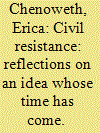

|
|
|
|
|
| Publication |
2014.
|
| Summary/Abstract |
IT HAS BEEN THREE YEARS SINCE WHY CIVIL RESISTANCE WORKS HIT THE shelves.1 When Maria J. Stephan and I sent the final galleys into the publisher, we had no idea that the Arab Spring was about to grip the world; that the Occupy movement would reenergize the protest sector in advanced
democracies; or that countries as diverse as Turkey, Venezuela, Ukraine, Thailand, and India would be rocked by nonviolent resistance against entrenched authority, lack of economic opportunity, and corruption. While many people have cataloged the global decline in armed conflict, few have noticed that, in the meantime, the use of civil resistance has been on the rise.
|
|
|
|
|
|
|
|
|
|
|
|
|
|
|
|
| 3 |
ID:
137035


|
|
|
|
|
| Summary/Abstract |
While several existing datasets can help to address pressing questions on nonviolent resistance, data collection on nonviolent conflict involves several distinct challenges, including (1) conceptual distinctions between the absence of violence, non-violent behavior, and nonviolent direct action; (2) a systematic violence bias in mainstream news reports; and (3) incentives to misrepresent. As a way forward, we advocate (1) collecting data at multiple temporal and purposive units; (2) diversifying source materials; and (3) coding ambiguity as a meaningful substantive variable.
|
|
|
|
|
|
|
|
|
|
|
|
|
|
|
|
| 4 |
ID:
132148
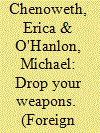

|
|
|
|
|
| Publication |
2014.
|
| Summary/Abstract |
Over the past three years, the world has witnessed a surge of nonviolent resistance movements. Pictures of huge demonstrations in public squares have become a staple of international news broadcasts, and Time named "the protester" as its Person of the Year for 2011. These days, it seems that at any given moment, thousands of people are mobilizing for change somewhere in the world.
|
|
|
|
|
|
|
|
|
|
|
|
|
|
|
|
| 5 |
ID:
190016
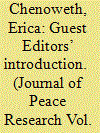

|
|
|
|
|
| Summary/Abstract |
In the past decade, myriad studies have explored the effects of nonviolent resistance (NR) on outcomes including revolutionary success (short-term and long-term) and democratization, and how nonviolent mobilization can play a similar role to violence in affecting social change in some settings. This special issue seeks to advance our understanding of the role of nonviolence by tackling some key assumptions in existing work that are complicated by historical and contemporary realities of deepening polarization worldwide. This issue addresses four key areas within conflict and peace research that limit our ability to make sense of NR: (a) the fragmented nature of civil resistance campaigns in terms of supporters and demands; (b) the increasing prevalence of authoritarian or anti-egalitarian nonviolent campaigns; and (c) the complicated nature of revolutionary success. Cutting across all three of these substantive areas is another key area, which is: (d) the United States as an increasingly salient site of conflict and contention.
|
|
|
|
|
|
|
|
|
|
|
|
|
|
|
|
| 6 |
ID:
165455
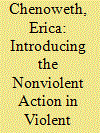

|
|
|
|
|
| Summary/Abstract |
Scholarship on civil war is overwhelmingly preoccupied with armed activity. Data collection efforts on actors in civil wars tend to reflect this emphasis, with most studies focusing on the identities, attributes, and violent behavior of armed actors. Yet various actors also use nonviolent methods to shape the intensity and variation of violence as well as the duration of peace in the aftermath. Existing datasets on mobilization by non-state actors – such as the Armed Conflict Events and Location (ACLED), Integrated Conflict Early Warning System (ICEWS), and Social Conflict Analysis Database (SCAD) – tend to include data on manifest contentious acts, such as protests, strikes, and demonstrations, and exclude activities like organizing, planning, training, negotiations, communications, and capacity-building that may be critical to the actors’ ultimate success. To provide a more comprehensive and reliable view of the landscape of possible nonviolent behaviors involved in civil wars, we present the Nonviolent Action in Violent Contexts (NVAVC) dataset, which identifies 3,662 nonviolent actions during civil wars in Africa between 1990 and 2012, across 124 conflict-years in 17 countries. In this article, we describe the data collection process, discuss the information contained therein, and offer descriptive statistics and discuss spatial patterns. The framework we develop provides a powerful tool for future researchers to use to categorize various types of nonviolent action, and the data we collect provide important evidence that such efforts are worthwhile.
|
|
|
|
|
|
|
|
|
|
|
|
|
|
|
|
| 7 |
ID:
150479
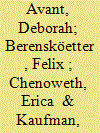

|
|
|
|
|
| Summary/Abstract |
The final issue of JoGSS’ first volume begins with paired articles on piracy and ends with a forum on censorship. These bracket an innovative argument about the importance of first impressions for threat perception and a careful empirical analysis of why support for the draft in the United States has waned. The articles in this issue showcase a wide variety of methods, many different theoretical starting points, and engage both contemporary and historical issues.
|
|
|
|
|
|
|
|
|
|
|
|
|
|
|
|
| 8 |
ID:
155781
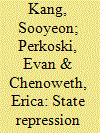

|
|
|
|
|
| Summary/Abstract |
In this article, we review decades of research on state repression and nonviolent resistance. We argue that these two research programs have converged around six consensus findings. We also highlight several areas of divergence, where greater synthesis between the research on state repression and nonviolent resistance might prove useful. We draw attention to remaining controversies surrounding the association between state repression and nonviolent resistance—particularly regarding different theoretical assumptions about structure, agency, and strategic choice; measurement challenges for both repression and dissent; methodological challenges regarding endogeneity, multicausality, and equifinality; and moral hazards associated with the study of nonviolent resistance and the effectiveness of repression. We conclude by highlighting some productive ways forward.
|
|
|
|
|
|
|
|
|
|
|
|
|
|
|
|
| 9 |
ID:
120765
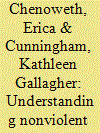

|
|
|
|
|
| Publication |
2013.
|
| Summary/Abstract |
The events of the Arab Spring of 2011 have made clear the importance and potential efficacy of nonviolent resistance, as well as the field's inability to explain the onset and outcome of major nonviolent uprisings. Until recently, conflict scholars have largely ignored nonviolent resistance. This issue features new theoretical and empirical explorations of the causes and consequences of nonviolent resistance, stressing the role that unarmed, organized civilians can play in shaping the course of conflicts. Contributors demonstrate the importance of treating nonviolent and violent strategies, as well as conventional politics strategies, as alternative choices for engaging the state, show how gender ideology can influence which opposition groups use nonviolent resistance, and suggest that the causes of civil war and nonviolent resistance often differ. Other pieces highlight the role of public attitudes regarding whether nonviolent resistance and violence are employed, how experience with activism and repression by the state can shape activists' perceptions of justice, and how the perceptions of resistance leaders can influence strategic choices. Moreover, several articles examine the key role that security force defections can play in the success of nonviolent resistance, how micro-level nonviolent tactics can improve security in civil war, and how nonviolent campaigns can influence the stability of autocratic states. These contributions suggest that rigorous empirical study of civilian-based contentious politics (rather than only violent contention by armed non-state actors) must be incorporated into the conflict literature. Improved theory and data on the subject will help researchers and policymakers to shape strategies to support these movements when appropriate, and to manage changes in the international system that result from the success of nonviolent uprisings.
|
|
|
|
|
|
|
|
|
|
|
|
|
|
|
|
| 10 |
ID:
120775
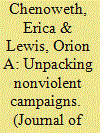

|
|
|
|
|
| Publication |
2013.
|
| Summary/Abstract |
Recent studies indicate that strategic nonviolent campaigns have been more successful over time in achieving their political objectives than violent insurgencies. But additional research has been limited by a lack of time-series data on nonviolent and violent campaigns, as well as a lack of more nuanced and detailed data on the attributes of the campaigns. In this article, we introduce the Nonviolent and Violent Campaigns and Outcomes (NAVCO) 2.0 dataset, which compiles annual data on 250 nonviolent and violent mass movements for regime change, anti-occupation, and secession from 1945 to 2006. NAVCO 2.0 also includes features of each campaign, such as participation size and diversity, the behavior of regime elites, repression and its effects on the campaign, support (or lack thereof) from external actors, and progress toward the campaign outcomes. After describing the data generation process and the dataset itself, we demonstrate why studying nonviolent resistance may yield novel insights for conflict scholars by replicating an influential study of civil war onset. This preliminary study reveals strikingly divergent findings regarding the systematic drivers of nonviolent campaign onset. Nonviolent campaign onset may be driven by separate - and in some cases, opposing - processes relative to violent campaigns. This finding underscores the value-added of the dataset, as well as the importance of evaluating methods of conflict within a unified research design.
|
|
|
|
|
|
|
|
|
|
|
|
|
|
|
|
| 11 |
ID:
189002
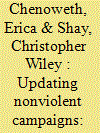

|
|
|
|
|
| Summary/Abstract |
In this article, we introduce an updated version of the Nonviolent and Violent Campaigns and Outcomes dataset (NAVCO 2.1), which compiles annual data on 389 nonviolent and violent mass movements for regime change, anti-occupation, and secession from 1945 to 2013. This version of the dataset corrects known coding errors in NAVCO 2.0, adds news cases (including the Arab uprisings), and codes attributes for each campaign year (such as participation size and diversity, the behavior of regime elites, repression and its effects, support from external actors, and campaign outcomes). In addition, NAVCO 2.1 adds several new attributes to each campaign-year, including more precise participation figures, more nuanced data about the scope, intensity, and degree of violent flank behavior and state repression, and further information about the parallel or alternative institutions developed by the campaign. The data reveal four key findings: (1) that the success rate of nonviolent resistance campaigns has declined since 2001; (2) that far more people have participated in nonviolent than violent campaigns in the postwar period; (3) that nonviolent campaigns suffer far fewer per-capita fatalities than armed campaigns; and (4) that incidental violence by dissidents has become a more common feature of contemporary nonviolent campaigns compared with earlier cases. The article concludes with suggestions for further research.
|
|
|
|
|
|
|
|
|
|
|
|
|
|
|
|
| 12 |
ID:
083093
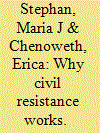

|
|
|
|
|
| Publication |
2008.
|
| Summary/Abstract |
The historical record indicates that nonviolent campaigns have been more successful than armed campaigns in achieving ultimate goals in political struggles, even when used against similar opponents and in the face of repression. Nonviolent campaigns are more likely to win legitimacy, attract widespread domestic and international support, neutralize the opponent's security forces, and compel loyalty shifts among erstwhile opponent supporters than are armed campaigns, which enjoin the active support of a relatively small number of people, offer the opponent a justification for violent counterattacks, and are less likely to prompt loyalty shifts and defections. An original, aggregate data set of all known major nonviolent and violent resistance campaigns from 1900 to 2006 is used to test these claims. These dynamics are further explored in case studies of resistance campaigns in Southeast Asia that have featured periods of both violent and nonviolent resistance.
|
|
|
|
|
|
|
|
|
|
|
|
|
|
|
|
|
|
|
|
|